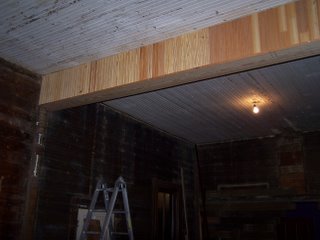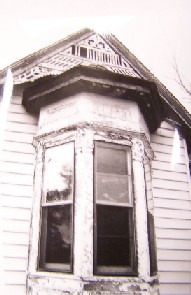Yet Another Victim of Recreational Drug Use
If anyone in my household deserves the moniker of Resident Genius, it is my wife. She's too modest and filled with self-loathing to actually accept such a title, but it's true. I know you're wondering what I did to launch into this marathon of spousal butt kissing, but it's not like that, really. The other night my wife conjured up a definitive answer as to why we have that weird beam between our living room and dining room, and that is genius.
Using Occam's Razor as a guide, she came up with the simplest explanation possible: Cocaine.
The 1980's were a tragic decade for fashion, architecture, and American pop-culture as a whole. Whether cocaine was the cause of these social and aesthetic problems or society's way of coping with such ugly shit is still a topic of considerable debate among sociologists.
Prior to my wife's inspired revelation, we had believed the wall between these two rooms had been removed in the 1920's when major renovations were made to the Queen. Upon closer inspection, the evidence points to a different conclusion.
First, Victorians loved doors and they loved enclosed spaces. Everything had its proper place, and their homes reflected this. It is probable that the Boswell's left the wall intact only adding a doorway to the new additions. There is a trace of a threshold still visible on the living room floor that supports this.
Second, after Kenny removed all the dry wall from the beam and surrounding walls, a considerable amount of new (20-30 year old) wood was used to support the beam. The drywall, the thin sheets of wood paneling, and other "improvements" all seem to date to the same time period as the wood. This suggests that they were all installed at roughly the same time.
 Third, the whole great room (combined living & dining area or kitchen & living area) idea was popular in the late 1970's & the 1980's. My mother's house (c. 1975) is a prime example of this style of design.
Third, the whole great room (combined living & dining area or kitchen & living area) idea was popular in the late 1970's & the 1980's. My mother's house (c. 1975) is a prime example of this style of design.
So, based on this evidence, I'm thinking that the previous owners sucked a fat mountain of coke up their nose and tore the freaking wall out for posterity. It also goes a long way to explain why the style of these two rooms doesn't quite match the rest of the Queen.
As part of our long term renovation plan, we're thinking about installing some period fretwork & decorative columns under this beam to help blend it into the Queen's overall design.

Out of curiosity, is Victorian era interior fret work more prevalent in some parts of the US than others? I only ask because my wife and I have never seen an example of it in the South. We're wondering if this yet another regional difference in style like the South's propensity for horizontal beadboard walls vs. vertical beadboard in other regions. Thoughts?
Using Occam's Razor as a guide, she came up with the simplest explanation possible: Cocaine.
The 1980's were a tragic decade for fashion, architecture, and American pop-culture as a whole. Whether cocaine was the cause of these social and aesthetic problems or society's way of coping with such ugly shit is still a topic of considerable debate among sociologists.
Prior to my wife's inspired revelation, we had believed the wall between these two rooms had been removed in the 1920's when major renovations were made to the Queen. Upon closer inspection, the evidence points to a different conclusion.
First, Victorians loved doors and they loved enclosed spaces. Everything had its proper place, and their homes reflected this. It is probable that the Boswell's left the wall intact only adding a doorway to the new additions. There is a trace of a threshold still visible on the living room floor that supports this.
Second, after Kenny removed all the dry wall from the beam and surrounding walls, a considerable amount of new (20-30 year old) wood was used to support the beam. The drywall, the thin sheets of wood paneling, and other "improvements" all seem to date to the same time period as the wood. This suggests that they were all installed at roughly the same time.
 Third, the whole great room (combined living & dining area or kitchen & living area) idea was popular in the late 1970's & the 1980's. My mother's house (c. 1975) is a prime example of this style of design.
Third, the whole great room (combined living & dining area or kitchen & living area) idea was popular in the late 1970's & the 1980's. My mother's house (c. 1975) is a prime example of this style of design.So, based on this evidence, I'm thinking that the previous owners sucked a fat mountain of coke up their nose and tore the freaking wall out for posterity. It also goes a long way to explain why the style of these two rooms doesn't quite match the rest of the Queen.
As part of our long term renovation plan, we're thinking about installing some period fretwork & decorative columns under this beam to help blend it into the Queen's overall design.

Out of curiosity, is Victorian era interior fret work more prevalent in some parts of the US than others? I only ask because my wife and I have never seen an example of it in the South. We're wondering if this yet another regional difference in style like the South's propensity for horizontal beadboard walls vs. vertical beadboard in other regions. Thoughts?



7 Comments:
Almost all of the folk Victorians in my neighborhood of Nashville that have their original woodwork intact have fretwork spandrels somewhere in the house, usually across the hallway, visible from the front door. Not my house, of course, but I intend to remedy this eventually.
I've seen some transitional Craftsman/Victorian (since our part of the city seemed very confused about the distinction between those two periods, but that certainly wouldn't have been the first time Fredneck was a little backwards) interior fretwork column details that might look really nice there. Two small bookshelves on each side, a column on top of each bookshelf, and then different (depending on the house) ways to trim out the area where the columns meet the beam. All the houses I've seen with this detail have it in the house between the foyer and the living room, or the living room and the dining room. If you're interested, I can go around and get my friends to let me take pictures. Our house either had this detail and it was removed when the staircase was redirected, or it never had it to begin with.
The whole fret work thing was wildly available from catalogs and very much in style. I’m sure with a lot of things, though, if is was available close by it was more likely to be used. Just because you could order something from Chicago doesn’t mean you did. If there was a big local supplier of what ever was hip and trendy you were more likely to see it. If there wasn’t a local supplier then maybe only the more upwardly mobile had it.
I know for certain there is fretwork in the house on the corner of 7th and? across from the Albert Pike (now decorative arts museum) home. I saw it back in the seventies when I was in there.
This comment has been removed by a blog administrator.
Thanks to everyone for all the info.
Nightmare, if you have any photos of fretwork, I'd love to see them. I have Dover edition of an old millwork catalogue, but nothing beats photos.
Based on what you all have said, I'm guessing that fretwork either wasn't readily available or they just weren't interested in it.
Thanks again!
4:10 PM
There's at least one Victorian house with fretwork in Eutaw. Seems like I've seen others but can't remember right now. The house we considered in Greensboro had lovely fretwork also. Ours has none, but I wouldn't doubt if it did at one time. Our entry hall had some renovation done in the '20s or '30s, so there's no knowing what was there before.
Anyway, here's the link to the web site of that Victorian house in Eutaw. It has amazing original woodwork throughout the first floor. There's one pic that shows the fretwork:
http://www.angelfire.com/al2/malloyjonesshaw/
Post a Comment
<< Home